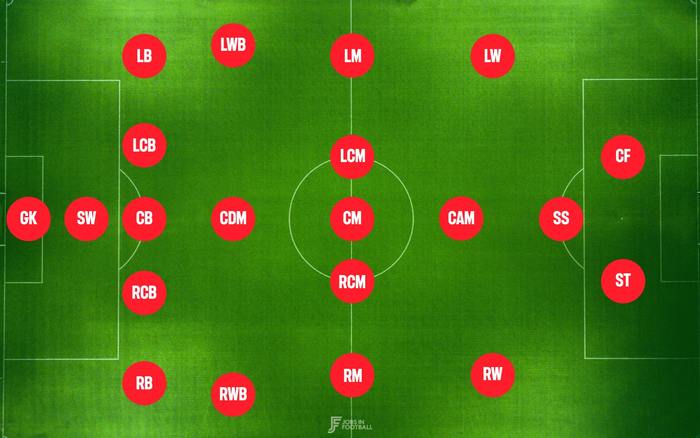Home » Mastering Football Positions: A Comprehensive Guide
Mastering Football Positions: A Comprehensive Guide

The world of Football is in a perpetual state of evolution, with coaches, tacticians, and players constantly seeking innovative ways to gain a competitive edge. This dynamism is evident in the exploration of new formations and tactical systems. Football formations, such as 4-4-2 or 4-5-1, hinge on a solid back line, while formations like 3-4-3 present diverse attacking opportunities. Regardless of the formation, a fundamental requirement is a deep understanding of the various Football positions on the pitch.
Unraveling the 11 Football Positions
In a Football game, each team consists of 11 players, categorized into four main areas: Goalkeeper, Defense, Midfield, and Attack. The specific positions may vary based on the formation, but a traditional 4-4-2 lineup typically includes:
- Goalkeeper
- Right Fullback
- Left Fullback
- Center-back
- Center-back
- Center Midfield
- Center Midfield
- Right Midfield/Wing
- Forward
- Forward
- Left Midfield/Wing
These positions are generally classified into three main areas: defense, midfield, and attack.
Decoding Football Positions: A Deep Dive
- Goalkeeper
The goalkeeper, positioned between the sticks, serves as the last line of defense. Their role is unique, requiring specific skills distinct from outfield players. Notable skills include:
- Catching: Mastery in catching the ball in various situations.
- Shot stopping: Anticipating and blocking shots effectively.
- Organization: Commanding the penalty area and organizing the defense.
- Kicking: Delivering powerful, precise goal kicks.
- Footwork: Emphasizing agility and technical prowess.
- Reflexes and Agility: Swift and flexible movement around the goal.
Alternate Names for Goalkeepers: Goalie, Stopper, Shot stopper, Goaltender.
- Center-back
Central defenders, or center backs, focus on thwarting opponents’ goal attempts, winning defensive battles, and progressing the ball forward. Key skills include:
- Positional Discipline: Reading the game and maintaining positional awareness.
- Aerial Ability: Dominating in aerial duels.
- Tackling: Executing clean, well-timed tackles.
- Passing: Proficiency in controlling and passing the ball.
- Leadership: Effective communication and instruction.
Alternate Names for Center-backs: Central Defender, Center-half, Stopper.
Variation: Sweeper
The sweeper, or libero, positioned deeper than traditional center-backs, specializes in sweeping loose balls and ball-playing responsibilities.
- Full-back
Encompassing left back and right back, fullbacks are wider defenders. They primarily focus on defense but are expected to contribute offensively. Noteworthy skills include:
- Speed: Essential for dealing with pacey wingers.
- Stamina: Vital for covering the pitch efficiently.
- Positional Awareness: Balancing defensive and attacking responsibilities.
- 1v1 Defending: Competence in one-on-one defensive situations.
Alternate Names for Fullbacks: Right Backs, Left Backs.
Variation: Wingback
Wingbacks, with a more attacking focus, are used in formations like 3-5-2 or 3-4-3.
- Center-midfielder
Central midfielders play a crucial role in connecting defense with attack. Types include defensive midfielders (CDMs) and attacking midfielders (CAMs). Key skills comprise:
- Passing Ability: Varied and precise passing under pressure.
- Ball Control: Swift control for quick ball movement.
- Dribbling: Ability to beat opposition players.
- Tackling and Intercepting: Essential for regaining possession.
- Shielding: Protecting the ball under pressure.
- Energy & Fitness: Vital for box-to-box midfielders.
Alternate Names for Center-midfielders: Defensive Midfielder, Attacking Midfielder, Box-to-box Midfielder.
Variations: Defensive Midfielder, Attacking Midfielder, Box-to-box Midfielder
Each variation has distinct responsibilities, emphasizing defense, attack, or both.
- Wide Midfielder
Situated in wider areas, wide midfielders contribute to attacking play. Essential skills include:
- Technical Ability: Proficiency in ball control and dribbling.
- Speed: Necessary for beating defenders.
- Dribbling: Quick and skillful dribbling.
- Shooting Ability: Accurate finishing.
Alternate Names for Wide Midfielders: Left Midfielder, Right Midfielder.
Variation: Winger
Wingers, more attacking than wide midfielders, play a vital role in formations like 4-3-3.
- Forward
Forwards, responsible for scoring goals, encompass various positions, including target man, false nine, and inverted wide forwards. Key skills include:
- Shooting Ability: Proficiency in various shooting techniques.
- Composure: Calmness in high-pressure situations.
- Technical Skill: Strong ball control, passing, and dribbling.
- Intelligent Movement: Strategic understanding of offensive positioning.
- Hold-up Play: Acting as a focal point for the team.
Alternate Names for Forwards: Striker, Second Striker, Center Forward, Inside Forward, Finisher, Poacher, Target Man.
Variations: Striker/Center-forward, Second Striker
Strikers focus on goal scoring, while second strikers support the main striker from a slightly deeper position.
Mastering Football Positions for Enhanced Enjoyment
With a detailed understanding of Football positions, spectators can spend more time appreciating the game. Whether you’re intrigued by the intricacies of the 4-2-4 formation or curious about gegenpressing (counter-pressing), expanding your tactical knowledge enhances the Football-watching experience.
Football Position Abbreviations
To decipher formation diagrams and gaming platforms like FIFA or Football Manager, familiarize yourself with common Football position abbreviations:
- GK: Goalkeeper
- D: Defender
- SW: Sweeper
- CB: Center Back
- RCB: Right Center Back
- LCB: Left Center Back
- RB: Right Back
- LB: Left Back
- WB: Wing Back
- RWB: Right Wing Back
- LWB: Left Wing Back
- M: Midfielder
- DM: Defensive Midfielder
- CDM: Center Defensive Midfielder
- CM: Center Midfielder
- RM: Right Midfielder
- LM: Left Midfielder
- AM: Attacking Midfielder
- CAM/AMC: Centre Attacking Midfielder
